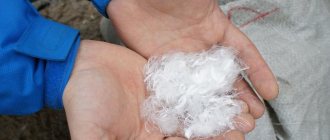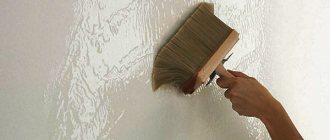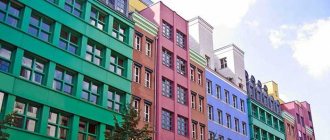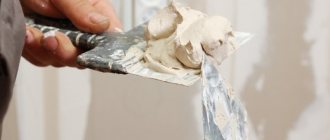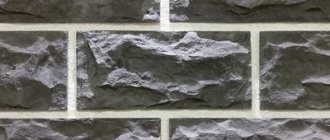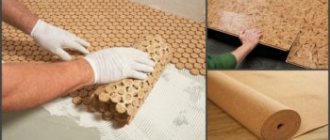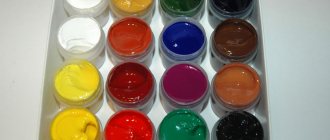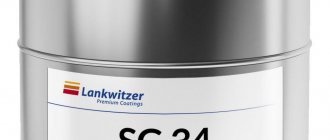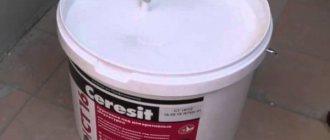Concrete and its mixtures have been known to mankind for more than six thousand years. The modern version (with cement as a binder) has been used since 1844. Add aggregate (gravel or crushed stone) to the mortar and you will get a monolithic mixture that is not only as strong as stone, but even superior to stone! Water, which is part of such a super-stone, is necessary for its production, however, it is the main destructive force inside the concrete. Frost and sun do not have a miraculous effect on the monolith: frozen water expands microcracks, and the heat “melts” this water, like honey from a honeycomb. That is why concrete primer is used; it can protect the surface from various factors.
Add here also external rains with blowing winds, all sorts of moldy fungi, plant roots trying to penetrate every small concrete crack, and it will become clear to you that products even made from such a durable material need protection. Protection consists of primary and secondary measures, the purpose of which is to ensure maximum impermeability of concrete products (structures).
“Primary” is the compaction of the concrete structure with various penetrating building mixtures, which guarantee its frost resistance and compressive strength. “Secondary” - additional coatings on the concrete surface, forming a kind of film-membrane to protect the external parts of the products from an aggressive environment.
What do we choose from the secondary market? Anti-corrosion and waterproofing will be fully ensured by a special hardening impregnation or primer for concrete surfaces.
Is this difference fundamental? - No! Having studied many complex construction terms, we find out that both of these compositions perform the same functions: penetrating inside concrete walls, ceilings and floors, they close the pores, strengthen the top layer, remove dust from the concrete surface, giving it excellent adhesion (sticking of paint or glue ) for subsequent work. This property of primer and impregnation allows you to significantly save on finishing materials, because after their use, putty, paint, wallpaper and linoleum glue are laid down in an even thin layer, and this is also an important detail.
On video: deep penetration primer.
The only difference is in density - the primer is thicker in consistency, and the hardening impregnation is a little thinner, which allows it to penetrate much deeper into microcracks. Primers for concrete for painting (also known as impregnation) will perfectly protect the surface from the effects of acids and alkalis; in this case, only paint placed on top of the primer can “fail”; the concrete itself will remain undamaged.
Both the primer and the impregnation are made from the same binder polymer compositions, which include insulating components of polyurethane, polyester, perchlorovinyl or epoxy materials. In addition, they have the same base - either organic or ordinary water H2O. Clean and environmentally friendly!
Neglect of soil for concrete can lead to irreparable consequences - cracks, fungus, chips and falling pieces will gradually destroy even the strongest wall!
But all that had to be done was to ensure optimal strength of the base - prime it! Starting finishing work or repairs without using primer mixtures is a waste of time and materials. Which primer is best? One that is intended for mineral surfaces, for example, a deep penetration primer.
How to choose
The choice of working material is based on many design, technological and climatic parameters.
Type and strength of concrete base
When working with standard concrete bases, the grade strength of which is within M150-M300, polyurethane and epoxy primers are used. If the base is made of polymer-cement, magnesium floors, concrete with a strength of M350 or higher, it is recommended to use deep penetration primers. The same materials are best used for compacting and strengthening weak concrete floors (up to M150).
Application conditions
If work must be carried out at subzero temperatures, polyurethane primer is used. If it is necessary to apply the composition to a damp base, use a deep primer or deep penetration primer. If the smell is unacceptable during work, use epoxy primer.
Other parameters
In some conditions, it is necessary to take into account the level of vibration loads on the floor, chemical resistance parameters, and the time during which the object must be put into operation.
Stages of surface cleaning and primer application
1. Before applying the primer to the base, it is recommended to thoroughly clean it with your own hands from the previous coating, where, most likely, unnecessary dust has accumulated.
2. All existing defects (cracks, irregularities) on the surface must be completely eliminated.
3. Next, a deep penetration primer for concrete should be applied to the base, which will help strengthen the damaged areas.
4. After completing the above steps, the base should be leveled.
It is also recommended to prepare them before painting the walls. A deep penetration primer for concrete is also used for this.
Recommendations: to protect the surface from microorganisms that can cause harm, you should use a primer that contains an antiseptic. It is used when treating external walls of buildings, as well as in rooms with high levels of moisture.
Epoxy primer for concrete
Primers of this type are made on the basis of epoxy resins.
Ready-made compositions are characterized by unique characteristics, which are in demand on any concrete base. Such materials are used for painting, for installing all types of epoxy floors (self-leveling, thin-layer, quartz-filled), and for pouring economical thin-layer transparent coatings.
Types of epoxy primers:
Technical specifications
Epoxy-based primers have high adhesion strength to concrete. The material provides good moisture protection and is fireproof. The finished layer demonstrates strength and resistance to wear during operation.
We can say that soils are characterized by deep penetrating ability, which contributes to the compaction and strengthening of concrete from the inside. The composition will prevent cracking and peeling of finishing paints.
The finished layer dries after 24 hours . The only limitation in application is that the material should not be spread over wet substrates. One of the significant advantages of epoxy floors is the absence of odor during application.
To revive the composition, it is heated, preferably in a water bath. Warm-up temperature – up to +60 degrees. This operation will return all original properties.
Objects of application:
Typical technical parameters of two-component epoxy primers are discussed in the table:
| Mass ratio of two components | 2:1 |
| Mass. share of non-volatile substances, % | 100 |
| Viability of the finished solution, min | 30 |
| Touch dry, h | 8 |
| Resistance to static action of water, h | 48 |
| Resistance to static action of xylene, h | 48 |
| Resistance to butyl acetate, h | 24 |
Polyurethane primer for concrete
Polyurethane primers are considered one of the best. They are more affordable compared to previous analogues.
Technical specifications
This type of soil is not inferior to epoxy in terms of adhesion parameters, and adhesion to concrete does not depend on its actual absorption. The material works successfully on dusty surfaces, binding dust and strengthening the base.
A significant advantage of polyurethane-based compounds is their resistance to high temperatures. This allows them to be used with functioning underfloor heating systems, for treating external concrete floors and walls.
Types of polyurethane primers
2.Deep penetration . Such compositions are able to effectively absorb into the pores of concrete, penetrating to a depth of 4-6 mm or more. This solution is suitable for concrete grades M350 and stronger. Maximum hardening is achieved at M100-M300. Can work on wet surfaces .
3.Deep primer . This is a two-component composition with improved penetrating ability. In addition, it is characterized by astringency, which is effective when processing magnesium, polymer-cement concrete and other bases with low porosity.
When can you go to the bathhouse after coronavirus?
On weak concrete, the primer works as a strong hardener . After polymerization, a chemically resistant layer with high mechanical strength is formed. Deep soil is very fluid, works at the highest possible binding capacity and penetrates deep into concrete, including low-porosity, wet substrates. But, the consumption of such materials is 30-40% higher than that of simple polyurethane primers. To saturate concrete with M350 you will need about half a kilogram per 1 sq.m.
Deep soil is capable of exhibiting the texture of artificial stone and is suitable for application both indoors and outdoors. It is used as a sealing, strengthening, dust-removing agent on surfaces subject to high-intensity loads . The finished layer is resistant to shock loads and abrasion. After impregnation, the base takes on the appearance of varnished concrete.
The finished layer demonstrates constant resistance to the following negative factors:
Scope of application: low-porosity, dense, magnesium concrete, concrete tiles, high-strength concrete M350 and higher, moist but not wet bases, including those with poor quality waterproofing (there is capillary suction of water).
Typical technical parameters:
| Mass. fraction of non-volatile substances | 40% |
| Viability | 1 hour |
| Duration of layer-by-layer drying | 24 hours |
| Pedestrian load | A day later |
| Full mechanical load | After 3 days |
| Tensile strength | 27 MPa (after 14 days) |
| Elongation at break | 70% |
Best Primer Brands
Construction markets offer a large selection of impregnating primers at a variety of prices. In order not to overpay and choose the highest quality and durable composition, pay attention to the following products:
- Ceresit CT 17 is a universal impregnation that can penetrate even the smallest pores of the concrete base. Does not block the processes of steam and gas exchange, due to which the base “breathes”. Thanks to the coloring pigment Ceresit it is convenient to apply. This composition is available in two types: frost-resistant and summer. It costs about 450 rubles for 10 liters.
- Lakra is a polyurethane-based impregnating primer. Reliably protects concrete from the formation of mold and mildew. Thanks to antiseptic additives, it is optimally suited for bathrooms, baths and loggias. The mixture costs about 500 rubles per canister.
- Knauf Tiefengrud is a universal water-repellent primer designed for preparing the base before laying tiles, painting and wallpapering. It has high penetrating properties, so this composition is recommended for use on highly hygroscopic surfaces. The cost of such a primer is about 630 rubles per 10 kg.
- Knauf Betonokontakt - a dispersion of quartz sand based on polymers is well suited for poorly absorbent surfaces. This brand of primer is used for interior work and for preparing walls and ceilings for finishing with gypsum stucco. However, such a composition is quite expensive, from 3,100 rubles per 20 kg.
Acrylate, acrylic primers for painting
Materials of this group are used for processing concrete facades, as well as for indoor work with subsequent coating of walls with water-dispersion paints.
Acrylate primer improves adhesion, evens out the absorbency of the base, and provides a water-repellent effect . The finished layer helps reduce paint and varnish materials when applying finishing coatings.
The peculiarity of acrylic materials is that they are well suited for processing previously filled and plastered surfaces. The advantages of this solution are increased weather resistance, a significant increase in strength and adhesion to the base. Acrylic primer significantly reduces the consumption of finishing layers .
Typical technical characteristics of acrylic primers:
Latex primers for concrete for painting
Essentially, these are concentrates of synthetic polymers.
Materials of this type are distinguished by the fact that they create a moisture-proof, water-repellent coating on the surface of concrete. They are used indoors and outdoors, including on highly absorbent substrates. Latex reinforcements work effectively both on walls and on floors, including under heated floor systems. It is necessary to take into account that the composition is characterized by an antiseptic effect , prevents the development of mold, fungi, bacteria, which is important against the background of high humidity.
Latex primers are used in diluted or concentrated form. They are characterized by a milky white color and medium fluidity.
Proportions are chosen based on the goals of the work:
Typical technical parameters:
Application technology
Priming concrete for painting is one of the main technological operations. Any mistakes can affect the quality of the finishing coating, including complete replacement. These are serious and unjustified financial losses.
Concrete preparation
The principles of preliminary preparation are always the same.
All surfaces to be treated must be cleaned. The floors are sanded using a mosaic sander. It is permissible to use shot blasting or sandblasting, which is also important on vertical structures. Chemical cleaning may be used for walls. During the work, it is important to completely open the pores of the concrete and remove the laitance (on new concrete) . The weak surface layer, dirt, old coatings, and oily areas are completely removed from old concrete. Immediately before applying any type of primer, the surfaces are dusted with industrial vacuum cleaners.
Features of applying one-component polyurethane primers
In order for the material to work effectively, waterproofing is installed on the lower floors. This will eliminate backwater and capillary suction of water from below to the floors. If they are working on freshly laid structures, a 28-day curing period is required , given that the concrete matures under normal conditions.
Working conditions:
Application:
The average consumption of one-component polyurethane primers is 150-300 g/sq.m.
Features of the use of two-component polyurethane primers of deep penetration
Application conditions:
Application:
Features of the use of deep primers
Application conditions:
Application: the two-component composition is thoroughly mixed with a construction mixer. For high-quality kneading, 2-3 minutes and a speed of 300-400 rpm are enough. You should remember the viability of the mixture - 60 minutes . It is recommended to apply the finished composition with a polyamide roller or brushes in 2-4 technological approaches. Drying each layer takes 6-8 hours. Before painting, primer is applied until a uniform wet surface is obtained.
Features of applying acrylate primers
Application conditions:
Application can be carried out using rollers, brushes, and paint sprayers. It is enough to apply 1-2 layers, which depends on the actual condition of the surface . If a paint sprayer is used, the composition should be applied evenly and generously.
The average consumption is 1 kg/10-12.5 sq.m. Layer-by-layer drying time takes 1-2 hours under favorable application conditions. If the air humidity exceeds 65% and the temperature is below +15 degrees, the next layer is coated only after 12 hours of drying the previous one.
built-in bathroom furniture photo
Features of the use of acrylic primers
Application conditions:
Application: acrylic primers are applied with sprayers, brushes and rollers in 1-2 technological approaches. Layer-by-layer drying takes 10 hours, provided that the air temperature is above +20 degrees. The consumption of the composition depends on the roughness and absorbency of the surface. On average, it will take 0.2-0.3 kg to cover one square meter.
Features of using latex primers for painting
Application conditions: t surface, environment - +5+50 degrees . Before use, the soil is thoroughly mixed. The composition is brought to the required concentration.
The work is carried out using airless and air spray guns or using a brush or roller. It is recommended to apply the composition in 2 approaches, which will eliminate incomplete treatment of the base.
Drying time for each layer is 30 minutes . The finished surface must dry for at least an hour. Consumption depends on dilution proportions.
The concentrated solution is consumed in an amount of 50 g/sq.m., in a ratio of 1:2 - 16 g/sq.m., in a ratio of 1:5 - 8 g/sq.m.
Features of the use of alkyd primers
The primer is used in its pure form or requires dilution with organic solvents, such as white spirit. For application, brushes and rollers are used, applying the composition in 1-2 technological approaches. It must be remembered that the material is particularly toxic and requires compliance with fire safety standards.
How to paint concrete after priming
Paints intended for use on concrete differ in their protective, operational characteristics, and application features.
Epoxy paints
It is recommended to use epoxy primers for such materials. The paint itself is a two-component composition that requires mixing immediately before application. This is a good solution for interior work, especially for painting floors. This is due to its high chemical resistance, wear resistance, and water resistance.
Acrylic
Application is carried out over acrylic and acrylate primers. The material works well indoors, providing resistance to high humidity and temperature changes. This is facilitated by high decorative characteristics, a variety of textures and colors.
Polyurethane paints
The composition provides high resistance to chemical attack and other operational loads. In practice, application is carried out on concrete coated with polyurethane primers (one- or two-component). The main purpose is to cover floors. Like acrylic compositions, a nice appearance is ensured.
Rubber
This wear-resistant paint is renowned for its resilience. A film based on such material can be bent and rolled without breaking its integrity. These properties work well under mechanical loads, which is why the material is used to cover indoor floors. It is better to apply rubber paint over an acrylic primer.
Urethane-alkyd
The material demonstrates high hiding power and high abrasion resistance. The finished surface is glossy, but you can expect a wide variety of colors. The paint adheres well to alkyd primers.
Properties of primers
Concrete is considered a durable material, but under the influence of negative environmental factors it gradually deteriorates. Some properties can be corrected using a primer:
- the coating becomes homogeneous, other materials intended for finishing (putty, linoleum, varnishes and paints, wallpaper) are easier to apply;
- the adhesion between finishing materials and the concrete surface improves;
- the concrete layer becomes stronger;
- the surface is less susceptible to the negative influence of the external environment (high humidity, exposure to chemicals);
- Many mixtures contain antiseptics that prevent mold and mildew;
- the consumption of materials (putty, glue, paint, varnish, enamels, etc.) is reduced;
- primer for concrete prevents the absorption of water, at the same time protects the material from drying out.
A primer will help remove fungal damage to concrete walls.
Primer for concrete floors - why is it needed?
The primer is a translucent whitish composition with a liquid consistency. Its main purpose is to level surfaces. The primer mixture acts by penetrating the upper layers of building materials and improving their smoothness and quality properties. It is applied before the final finishing of the surface, as a result of which the level of protection from moisture, destruction and fungal attack increases, and the degree of adhesion of materials increases (due to an increase in the contact area).
You can prime both vertical and horizontal planes, for example, floors. This treatment process is most often applied to concrete floor surfaces. Concrete itself is a durable material, but it does not resist aggressive influences (wind, moisture, vibrations) well enough - cracks appear in it, and dust that is hazardous to health appears in the fragile top layer.
A primer for a concrete floor greatly increases the period of its trouble-free operation, since it levels and polishes its rough surface, and also neutralizes the ability of the material to generate a lot of dust, compacting the top layer of concrete.
Note! The use of primer mixtures will also save paint and varnish materials by reducing their consumption.
Should I apply before laying laminate or tile?
Some novice builders sometimes wonder whether they need to prime a concrete floor before laying tile or laminate flooring. Considering that good surface preparation largely determines the service life of the floor covering, and strips of laminate laid on an uneven floor will quickly lose their attachment to each other, sag and creak, the answer is yes - of course, it’s worth it. Next, a polyethylene or cork backing is installed on the primed concrete and the laminate is directly installed.
solar powered tape for the garden
If you plan to make a tiled floor, then if the concrete base has increased dust, greasy stains, a previous layer of tiles, wear and tear or a layer of waterproofing (for example, in a bathroom), it is necessary to increase the level of adhesion using primer mixtures.
Additional Information! A negative answer to the question of whether it is necessary to prime the floor before laying tiles is possible only if there is “fresh” concrete as the base and the use of cement-based adhesive.
Types of primer solutions
If previously there was only one type of primer, which was used in all cases, now you can find a wide variety of these mixtures in construction stores.
They are divided into the following types according to the depth of penetration into the base of the floor:
According to the intended purpose, the floor primer is:
Reference! Often primer mixtures combine several purposes - for example, antiseptic and fireproof at the same time.
Which one to choose depending on the base being processed?
Floor primers should be selected based on the type of surface being treated: for new floors or previously rubbed; for porous or smooth surfaces and different base materials:
As a primer for a concrete floor under laminate or tile, a concrete-contact mixture is most often used to form a rough waterproofing film on the cement screed. Such floors last about 8 decades.
Also, when choosing primer mixtures, you should take into account the color of the base (it is desirable that it matches the finishing coat), the area to be treated, the consumption of soil (depending on the degree of absorption of the base), as well as the temperature of the priming site (there are frost-resistant and heat-resistant products).
Selecting material by type of room
Depending on the location of the priming work, choose different types of primer for tiles or other floor coverings:
Expert advice
When choosing soil:
1. It is necessary to identify why the composition is needed (to prepare the surface for plastering or painting, for waterproofing).
2. You should know what material the base is made of (fresh or old concrete, whether it is dense or cellular). Based on this, you should choose a primer with the appropriate characteristics.
3. It is necessary to calculate the primer consumption.
Recommendations: it must be remembered that the composition is not capable of strengthening concrete, therefore it should not be added to the solution.
The maximum penetration depth is 70 mm, which creates a protective layer. This material, like a bumper, takes the entire impact, performing the function of protecting the base.
A base treated with a primer will retain its properties much longer and better. But if this material is added to the solution, it will not become stronger without the use of additives specially designed for this purpose.
Recommendations: unreasonable use of soil in concrete can reduce the strength characteristics.
In order to add special components to a concrete solution that can enhance its strength, you must have a special construction or engineering education.
How and with what to apply primer to the floor surface
To perform priming work efficiently, it is advisable to have on hand the appropriate tool needed for it.
Thus, porous substrates (which include concrete) are easier to process with a spray gun, and poorly absorbent surfaces are primed with a paint roller or a wide brush with soft bristles for a more even distribution of the mixture.
Before starting all work, you should properly clean the work surface, clearing it of small mechanical debris, dust and dirt (you can use a construction vacuum cleaner). Next, the cracks are sealed using putty.
You can’t just pour primer on concrete - you need to follow the consumption standards for this material, and you shouldn’t save money either; it’s better to apply the primer in several layers. Initially, a deep penetration compound is used, then the floor is sanded and a final coat of primer is applied.
Attention! Do not mix primer with concrete.
Rules for using primer
Dry primer mixtures sold in stores are diluted according to the manufacturer's instructions with tap water. Application should be done evenly, trying to obtain a uniform surface without sagging. The direction of movement is from the far corner of the room - to the front door.
It is necessary to monitor the temperature and humidity in the room - the quality of priming depends on this.
A primer should be applied to the loose base until the mixture stops being absorbed, then you can proceed to the next stage of work.
Primer for application to walls
Primer is a mixture that is used before final finishing (painting, gluing wallpaper, tiles, plaster). It allows you to level the base, fill voids and improve the connection between the finish and the surface. Some mixtures have additional characteristics: for example, they protect against rust or mold.
Additionally! There is no need to look for something to replace wall primer with. The material is inexpensive, but important, on which it is better not to skimp.
Can I do it myself at home?
It's easy to figure out how to replace the primer from the store. It’s not difficult to make one at home, just buy the necessary ingredients, mix in the specified proportions and follow the instructions.
The do-it-yourself primer retains the same properties as the ready-made branded one. Plus, she saves money by not paying for branding and packaging. If you already have the ingredients at home, you won’t have to spend any money at all.
